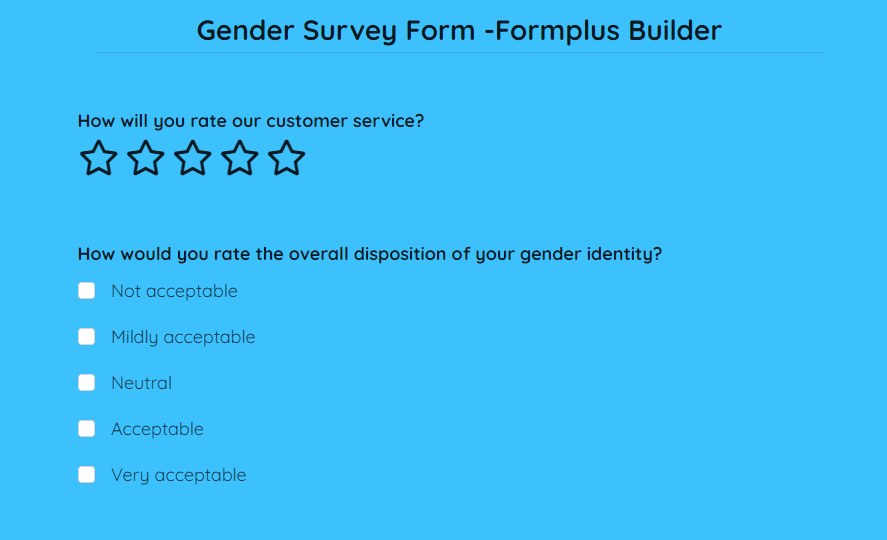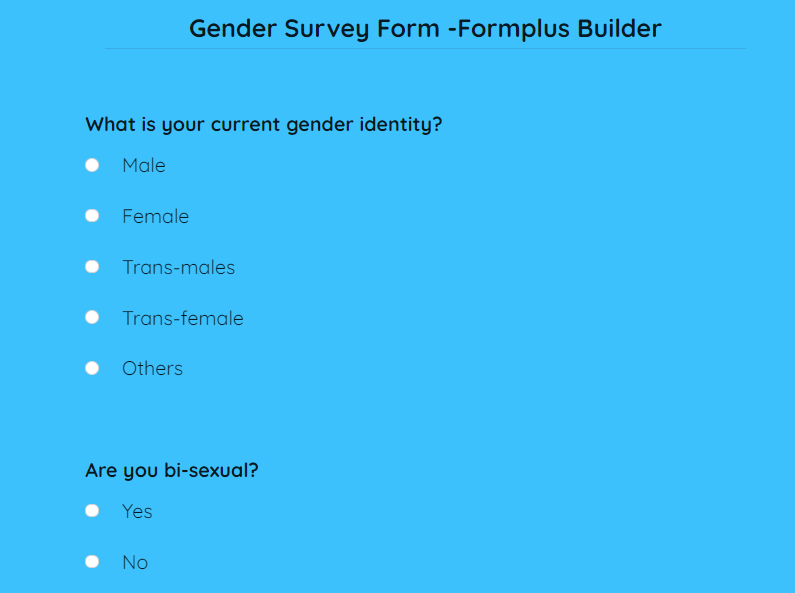In the past, it was somewhat easier to binarily categorize an individual as either male or female, gender-wise. These days, you may not be able to tell a person's gender or sexual orientation without asking or carrying out a gender survey.
As we usher in a new decade, it is important to note that you simply cannot assume that an individual fits into predetermined sexual or gender constructs. This is why carrying out a gender survey has become common practice; especially in formal environments.
Carrying out a gender survey is no mean task hence; it is important to know the kind of questions that should be contained in your survey plus other necessary information. If your gender survey puts respondents in a box, you may not achieve the most objective results at the end of the day.
Importance of Gender Survey
Gender is ever-evolving and clearly one of the most discussed issues of our time. People who subscribe to gender identities that are not male or female are often looking for a medium to express the realities of their gender identities and this is what a gender survey offers.
Gender surveys help organizations to accurately profile the gender spectra of their workforce and to develop gender-inclusive policies that cater to all genders present.
Gender surveys are important in institutions of learning because they help the school authorities to understand the gender balance, and how to protect minority gender identities from harassment and bullying.
By carrying out a gender survey, you would gain more insight into the peculiarities of each gender identity. Gender surveys, in the end, help people of different gender identities to have a sense of inclusiveness in their societies.
Types of Questions to Use for Gender Surveys
Close Ended Questions
A close-ended question is a type of question that limits the respondent to a few possible answers. This type of question typically requires survey respondents to choose from a limited set of predetermined responses which are already provided in the survey.
There are different types of close-ended questions that you can include in your gender survey. Examples include dichotomous questions, multiple-choice questions that require respondents to choose from provided options and rating scale questions which assign a qualitative measure to a particular gender concept or ideology.
Examples of Close-ended Questions
- What is your current gender identity?
- Male
- Female
- Trans-males
- Trans-female
- Others
- Are you bi-sexual?
- Yes
- No

- For how long have you been trans-female?
- 0-5 years
- 5-10 years
- 10-20 years
- More than 20 years
Open-Ended Questions
An open-ended question is a type of question that does not limit respondents to a range of predetermined answers. This type of question allows respondents to fully express themselves and provide thoughtful, deliberate, and sometimes, lengthy answers to gender survey questions.
The responses provided to open-ended questions can be up to a paragraph long or even an essay. Open-ended questions allow you to gain better insight into the respondent's thoughts, feelings and perceptions, and valuable information about the subject at hand.

Examples of Open-ended Questions
- Describe a scenario where you were discriminated against because of your gender.
- What was it like when you found out you were gay?
- How do you deal with gender discrimination?
Rating Questions
A rating question is a type of question that requires respondents to provide answers to survey questions by scaling these answers. It is a common type of question that allows survey respondents to rank their disposition towards the issues raised in the survey.

Examples of Rating Questions
- How would you rate the overall disposition of your gender identity?
- Not acceptable
- Mildly acceptable
- Neutral
- Acceptable
- Very acceptable
- How would you rate the level of gender bias in your immediate environment?
- Non-existent
- Mild
- Extreme
- Neutral
Tips for Asking Gender Questions in Survey
- Leave a Way Out
While drafting gender questions in a survey, it is important to always keep at the back of your mind the fact that gender is a spectrum. As such, you may not be able to fully reflect all gender types in your questions.
To avoid the problem of excluding persons of certain genders in your survey which may result in survey bias, it is best to leave a way out in your questions. Always include neutral options such as "others" or "doesn't apply" to avoid night survey dropout rates.
- Don't Be Afraid to Ask
The essence of a survey is to get people's honest opinions about important issues such as gender. Contrary to what is believed, people are quite enthusiastic about responding to well-crafted SOGI questions, in fact, people are more likely to skip questions about personal income than gender.
The trick, however, is to carefully word your questions so that they are not partial, biased or judgmental. People want to talk about gender but more importantly, they need to feel safe responding to questions about their gender or sexual orientation.
- Understand Your Audience
As earlier indicated, gender is socially defined and certain gender identities such as trans-male and trans-female are not formally recognized in many African and Asian societies. In this vein, it is important to craft gender questions in a survey; bearing in mind the gender stereotypes applicable in your survey environments.
Transgender or queer gender questions and options might not be applicable to surveys in Africa or Asia as much as they are in Europe and America. Always research on the gender laws and stereotypes in a country before creating SOGI questions.
- Don’t Ask Except It’s Important
Gender is as private as it gets already as such, there's no need to ask questions that probe unnecessarily into the personal lives of the respondents. Unless you plan to actually make use of the survey response data from a particular gender question, there's no reason to include it in your survey.
Sensitive gender questions in your survey may lead to high survey dropout rates or survey bias. When you ask the right questions, you would get meaningful insight into different gender identities and sexual orientations.
Read more about asking gender questions in a demographic survey

Gender Survey Questions Examples
- What gender do you identify as?
- Female
- Male
- Trans-male
- Trans-female
- Prefer to self describe
- Prefer not to say
- What is your sexual orientation?
- Bi-curious
- Bisexual
- Gay
- Androsexual
- Prefer to self describe
- Prefer not to say
- Do you identify with the gender status assigned to you at birth?
- Yes
- No
- Prefer not to say
- For how long have you been trans-female?
- 0-5 years
- 5-10 years
- 10-15 years
- 15-20 years
- 20 years and above
- Prefer not to say
- Highlight the stereotypes commonly faced due to your gender identity.
- Are you transgender?
- Yes
- No
- Prefer not to say
- If yes, which of the following are you?
- Trans-male
- Trans-female
- Non-conforming
- Prefer to self describe
- Prefer not to say
- What triggered your change of gender identity?
- Do you experience bias due to your gender identity?
- Yes
- No
- If yes, where do you experience the most gender bias?
- School
- Church
- Government institutions
- Media
- Prefer to self-describe
- How would you rate the overall disposition of your gender identity?
- Not acceptable
- Mildly acceptable
- Neutral
- Acceptable
- Very acceptable
- How would you rate the level of gender bias in your immediate environment?
- Non-existent
- Mild
- Extreme
- Neutral
- Have you ever been a victim of gender discrimination?
- Yes
- No
- Prefer not to say
- How long have you been gay?
- 0-5 years
- 5-10 years
- 10-15 years
- 15-20 years
- 20 years and above
- Prefer not to say
- Which of these sexual orientations do you identify as?
- Gay
- Bi-curious
- Pan-sexual
- Aromantic
- Prefer not to say
- Prefer to self-describe
- Do you feel attracted to all genders?
- Yes
- No
- Prefer not to say
- Do you feel attracted to people of the same gender?
- Yes
- No
- Prefer not to say
- Is there a community for people of your gender identity?
- Yes
- No
- Prefer not to say
- Are you bi-sexual?
- Yes
- No
- Prefer not to say
- If yes, for how long have you been bi-sexual?
- 0-5 years
- 5-10 years
- 10 years and above
- Prefer not to say
- How did you find out you were bi-sexual?
- What support systems do you have as a trans-male?
- What support systems do you have as a trans-female?
- Is there a support community for bisexual women?
- Yes
- No
- Prefer not to say
What is Sex?
Sex refers to the biological, genetic, and physiological factors that typically define individuals as being male, female, or hermaphrodite. According to MedicalNewsToday, sex can be viewed as the biological differences between males and females, such as the genitalia and genetic differences.
This means that sex is strictly a biological construct that is determined naturally during the conception process. It is important to note that in many instances, an individual's biologically assigned sexual orientation may not tally with his or her preferred gender identity.
Also, there are some individuals who embody male and female biological and physiological features. Such individuals are referred to as hermaphrodites or intersex.
What is Gender?
Gender is a social phenomenon that consists of a range of socially defined characteristics of masculinity and femininity. According to the Swiss Agency of Development and Control, gender is determined by the conception of tasks, functions, and roles attributed to women and men in society.
It is a flexible concept that typically differs from one society to another and can be changed over time. It is important to note that gender is a social spectrum that encompasses a wide range of possibilities between and beyond masculinity and femininity.
While many societies attempt to create a correspondence between one's sex and gender identity, it is important to note that this is not always the case. An individual may be born male but subscribe to femininity with regards to his gender and vice versa.
Differences between Sex and Gender
- Sex is biologically-defined while gender is socially constructed. One's sex is almost always determined at conception and is a function of hormones, chromosomes, and other physiological features while one's gender is defined by social norms, beliefs, and preferences.
- Sex is almost always binary while gender is a spectrum.
- Sex is due to nature while gender results from socio-cultural nurturing.
- Gender is flexible while sex is mostly fixed.
Types of Gender
- Male
Male is a gender type that is in line with masculinity and is typically used to refer to individuals (men and boys) who are physiologically and biologically constructed as male. Males have XY chromosomes and embody other genetically defined characteristics of maleness.
Males are cisgenders because they align with the social conditioning of their sex. In many societies, males are expected to be natural leaders, strong, aggressive, logically-driven, ambitious, sexual, physical, wealth-oriented, bold, risk-takers and emotionally-independent individuals, unlike their female counterparts.
- Female
Female is a gender type that aligns with femininity and is typically used to define individuals (women and girls) who are physiologically and genetically conditioned as female. Females have XX chromosomes and embody other biological criteria that define femaleness.
Females are cisgenders because they align with the gender stereotype of their sex. In many societies, females are socially conditioned to be weak, subservient, domesticated, emotionally-driven, emotionally-dependent, submissive, withdrawn, careful, sexually-appealing and fragile, unlike their male counterparts.
- Trans-Male
Transmale is a gender type for individuals who are born female and identify as male. In other words, it refers to an individual who was labeled female at birth but chooses to identify as male, gender-wise because she has a strong masculine identity.
Trans males often undergo a process of gender reassignment or transitioning that may involve certain surgical procedures plus social dynamism, and allows them to fully integrate with their gender identity. In recent times, there has been a lot of advocacy for transmale inclusion and non-discrimination in society.
- Trans-Female
Trans-female is a gender type that includes all male-to-female transgender individuals who are born male but choose femininity as their gender identity. Just like trans-males, trans-females often undergo gender reassignment or transitioning in order to fully integrate with their new identity.
- Gender Queer
GenderQueer is a gender identity that typically defines individuals who do not subscribe to conventional gender distinctions but instead, identifies as none, one or a combination of gender types. It refers to a spectrum of gender identities that are outside the conventional gender binary.
GenderQueer is also referred to as non-conforming or non-binary and involves transitioning between and among gender identities of male and female. Individuals who identify as genderqueer maintain that their gender is fluid, flexible and can shift from time to time as they evolve.

Types of Sexual Orientation
- Bi-Sexual
To be bi-sexual means being sexually attracted to both men and women. Bisexuality is a sexual orientation that defines people who are not exclusively physically and emotionally attracted to individuals of a particular gender type at different times of their lives.
- Gay
To be gay means to be attracted to an individual of the same sex as you are. According to the Australian Psychological Society, same-sex attraction is as normal and natural as heterosexual attraction; in fact, 1 in every 10 persons identify as gay.
- Asexual
To be asexual means to not experience any form of sexual attraction. Asexuality is a sexual orientation that defines individuals who are not interested in having penetrative or non-penetrative sex. with another individual even if they find such a person physically attractive.
- Demisexual
This sexual orientation refers to people in the asexual spectrum who only experience sexual or emotional attraction in certain situations. Such situations may involve after they must have formed a strong emotional or romantic connection with a partner.
- Other types of sexual orientation include pansexual, bi-curious, allosexual, aromantic, androsexual.
Why Should You Use Formplus for Gender Surveys?
Formplus is an online data gathering platform that you can use to collect and process form responses in real-time. This platform allows you to create different types of gender surveys and share them with multiple persons at the same time.
It has a unique customization feature that allows you to personalize your surveys, and include background images, preferred color themes, logos, image fields, and custom integrations. You can modify the Formplus survey template to gather gender survey responses from your target audience.
With Formplus, you can swiftly analyze survey responses by downloading survey response data as CSV files directly. This makes it easier to sort gender survey responses.

Conclusion
As with other types of surveys, having the right questions goes a long way to determine the success of your survey. Gender is a sensitive survey niche because it often involves individuals revealing information that is personal to them.
Therefore, it is best to always craft gender surveys to be objective, professional and straight to the point. In this article, we've highlighted a number of important information that you should always remember when it comes to creating gender survey questions.
More importantly, it is best to create online gender surveys using data-gathering platforms like Formplus because online gender surveys are easier to administer, track and analyze. Visit Formplus today to create your unique and personalized online gender survey forms.